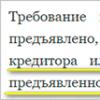Deposit operations represent operations of banks and other credit institutions to attract Money in deposits ( passive deposits) or placing the funds at their disposal on deposits with other banks or financial institutions (active deposits).
Contribution (deposit) is money (in cash or non-cash form, national or foreign currency), transferred to the bank by their owner for storage under certain conditions. Operations related to raising funds are called deposit operations.
For banks, deposits are the main type of their passive operations and, therefore, the main resource for conducting active credit operations. Passive operations are understood as such operations of banks, as a result of which there is an increase in funds held in passive accounts.
Passive operations play important role for commercial banks. It is with their help that banks acquire credit resources for money markets. There are 4 forms of passive operations of commercial banks:
primary issue valuable papers;
deductions from bank profits for the formation or increase of funds;
loans and borrowings received from others legal entities;
deposit operations.
Passive operations allow banks to attract funds already in circulation. New resources are created by the banking system as a result of active credit operations. With the help of the first two forms of passive operations (1, 2), the first large group of credit resources is created - own resources. The next two forms (3, 4) of passive operations create the second large group of resources - borrowed, or attracted, credit resources.
Deposit operations are operations of banks to attract funds from legal and individuals in deposits, either for specified periods or on demand. Deposit operations typically account for up to 95% of their liabilities.
The following may act as subjects of deposit operations:
- - state enterprises, institutions and organizations;
- - cooperatives;
- - joint stock companies;
- - mixed enterprises with foreign capital participation;
- - public organizations and funds;
- - financial and insurance companies;
- - investment and trust companies and funds;
- - individual individuals and associations of these individuals;
- - banks and other credit institutions.
The objects of deposit operations are deposits. They represent certain amounts funds (including the cost of securities) that subjects of deposit operations deposit into the bank, and which, due to the current procedure for conducting banking and financial transactions on certain time deposited in bank accounts.
There are various criteria for classifying deposits.
Scheme 1. Classification of bank deposit
Time deposits are funds deposited into deposit accounts for a strictly specified period with payment of interest. The rate on them depends on the size and term of the deposit. The fact that the owner of a time deposit can dispose of it only after the agreed period has expired does not exclude the possibility of early receipt of his funds from the bank. However, in this case, the client’s interest rate on the deposit is reduced. The bank is interested in attracting time deposits, since they are stable and allow the bank to have depositors' funds for a long time. Time deposits are classified depending on their term:
- 1. for up to 30 days
- 2. for a period of 31 to 90 days
- 3. for a period from 91 to 180 days
- 4. for a period from 181 days to 1 year
- 5. for a period of 1 year to 3 years
- 6. for a period of more than 3 years
Demand deposits are classified depending on the nature and ownership of funds stored in the accounts: funds in settlement, current, budget accounts of enterprises and organizations of different forms of ownership; funds in special accounts for storing various (according to their intended economic purpose) funds; own funds enterprises intended for capital investments; funds of enterprises and organizations in settlements; balances on correspondent accounts for settlements with other banks; federal and local budgets; balances of funds in the accounts of foreign correspondent banks. Demand deposits are placed in banks in various accounts opened for clients.
These deposits are intended for current settlements and can be fully or partially withdrawn at any time. Withdrawal of deposits is possible both in cash and in the form of non-cash payments.
Demand deposits are classified depending on the nature and ownership of the funds stored in the accounts:
- 1. funds in settlement, current, budget accounts of enterprises and organizations of various forms of ownership;
- 2. funds in special accounts for storing funds of various intended economic purposes (own funds of enterprises intended for capital investments;
- 3. funds of enterprises and organizations in settlements; funds in correspondent accounts for settlements with other banks; funds from local budgets).
Savings deposits are classified depending on the characteristics of their storage, the term and conditions of the deposit operation and are divided into:
urgent with additional fees;
winning;
monetary and material winnings;
youth premium;
conditional;
to bearer;
to current accounts;
poste restante;
deposit and savings certificates;
Plastic cards (credit cards, etc.).
Securities as a type of deposits are divided into bills of exchange traded on the market and deposit and savings certificates.
Each type of deposit has its own advantages and disadvantages. Demand deposits are the most liquid. Their owners can use the money in demand accounts at any time. The features of the deposit account are as follows:
money can be deposited or withdrawn into this account both in parts and in full without restrictions;
it is permitted to withdraw cash from this account in the manner established by the Central Bank of the Russian Federation;
the bank is obliged to maintain a minimum reserve with the Central Bank of the Russian Federation in a larger proportion than for time deposits.
The main disadvantages of demand deposits are:
for their owners - no interest payment on the account (or a very small percentage);
for the bank - the need to have a higher operational reserve to maintain liquidity (due to the potential for withdrawal of money from accounts on demand).
Time deposit accounts have a clear fixed time, they pay a fixed interest to the owners and, as a rule, there are restrictions on early withdrawal of deposits. Funds held in time deposit accounts are subject to a lower required reserve ratio than demand deposits.
The advantage of time deposit accounts for clients is that they receive high percentage, and for the bank - the ability to maintain liquidity with a smaller operational reserve.
Flaw time deposits for clients is low liquidity and the inability to use funds in time deposit accounts for settlements and current payments, as well as to receive cash.
Savings deposits are beneficial to banks in that they are usually long-term in nature and, therefore, can serve as a source long-term investments.
Flaws savings deposits for banks are as follows:
the need to pay increased interest on deposits and thus reduce the margin (the difference between interest on active and passive credit transactions);
exposure of these deposits to various factors (political, economic, psychological), which increases the threat of a rapid outflow of funds from these accounts and loss of bank liquidity;
the bank's inability to renew these resources on an ongoing basis.
Introduction........................................................ ...........................3
1. Theoretical basis implementation
deposit operations........................................................ .......6
1.1. The essence of deposit operations. Classification
deposit sources of raising funds...................................6
1.2. Features of demand deposits...................................................12
1.3. Characteristics of time and savings deposits...................16
2. Organization and procedure for accounting for deposit transactions...................21
2.1. Accounting for transactions on citizens' deposits...................................................21
2.2. Accounting for deposits of legal entities...................................................26
2.3. Accounting for interest on deposit transactions...................................29
3. Ways to improve deposit operations....................................33
Conclusion................................................. ......................36
List of references.........................................................38
Introduction
Nowhere in the world have bank deposits ever been a tool for making money and rather served as a hedge against inflation. Even in Russia, when deposit rates rose to sky-high levels, they rarely outpaced inflation. And only now, when inflation is steadily declining, Russians have a rare opportunity to earn a little money on bank deposits. Today the situation in the financial market is such that interest rates will decrease with a slowdown in inflation and a stable dollar exchange rate. This trend is confirmed, in particular, by the recent reduction by the Bank of Russia of the refinancing rate and the fall in government bond yields. Accordingly, rates on deposits in commercial banks will also decrease. Until recently, the rates on ruble deposits of most banks were 28-33% per annum, while the predicted inflation this year will not exceed 20%. Therefore, today, before rates fall, is the time to open long-term ruble deposits. With a stable dollar exchange rate, such deposits can bring 10 - 15% per annum in foreign currency, taking into account inflation.
True, banking experts advise cautious investors to keep funds in foreign currency deposits for a period of 3 to 9 months. Currently, their yield reaches 11 - 12% per annum. According to Alexey Osemnuk, head of the Rosbank customer service department, opening deposits for a period of more than nine months is risky, since “it is simply impossible to guarantee the stable operation of any credit institution for such a long period in modern Russian conditions.”
The bank's deposit policy is associated with inflationary processes, since they reduce the interest of households and the population in accumulating funds, and on the other hand, they increase the required reserve standards for the bank and lead to a sharp reduction in the volume of the bank's credit resources. This circumstance forces us to change the deposit policy by means of their diversification.
The deposit is mandatory, since the deposit amount must be paid simultaneously with the opening of a current account within the period agreed with the bank. Many deposits can create loan capital for the bank, which it then places on favorable conditions in any field of business. An important means of competition for attracting funds into deposits is the variety of interest rate policies. In addition to the high interest paid on deposits, the bank needs high guarantees of the reliability of placing accumulated resources in a given bank.
Along with maintaining deposit accounts, banks also use other methods of mobilization - this is attracting deposits from the population. To achieve this, banks carry out mutual cooperation with Western credit resources ( joint banks with foreign capital) and on this basis generate resources for paying interest to the population on deposit transactions.
The specificity of a banking institution as one of the types of commercial enterprise is that the overwhelming majority of its resources are formed not at the expense of its own, but at the expense of borrowed money. The possibilities of banks in raising funds are not unlimited and are regulated by the central bank in any state.
Since 1996, the Bank of Russia has abandoned direct regulation of the relationship between the size of a bank’s capital and the volume of attracted funds and switched to indirect regulation through a number of mandatory economic standards, such as the capital adequacy standard, maximum size risk per creditor, the maximum amount of attracting cash deposits from the population, etc.
The bulk of banks' resources are formed by borrowed funds, which cover up to 90% of the total need for funds to carry out active banking operations. Commercial Bank has the ability to attract funds from enterprises, organizations, institutions, the public and other banks in the form of deposits and open appropriate accounts for them.
The funds attracted by banks are varied in composition. Their main types are funds raised by banks in the process of working with clients (deposits), funds accumulated by issuing their own debt obligations (certificates of deposit and savings certificates).
A deposit (deposit) is funds (in cash and non-cash form, in national or foreign currency) transferred to the bank by their owner for storage under certain conditions. Operations related to attracting funds to deposits are called deposit operations. For banks, deposits are the main type of their passive operations and, therefore, the main resource for conducting active credit operations.
The relevance of the choice of the topic of work is connected with the vision of the problems of banks in the formation of a resource base and their effective placement in the conditions of reducing inflation, stabilization Russian currency and tightening requirements of banking regulators.
This is to attract funds from legal entities and individuals into deposits or certain period, or upon demand.
As subjects Deposit operations are carried out by enterprises of all organizational and legal forms and individuals.
Objects deposit transactions are deposits, i.e. amounts of funds that subjects of deposit transactions deposit into bank accounts.
Carrying out deposit operations requires each credit institution to develop its own deposit policy. which should be understood as a set of activities commercial bank aimed at determining the forms, tasks, content of banking activities in the formation of banking resources, their planning and regulation.
The ultimate goal of developing and implementing an effective deposit policy of any commercial bank is to increase the volume of the resource base while minimizing the bank's expenses and maintaining the required level of liquidity, taking into account all types of risks.
Since each bank develops a deposit policy, then main question not only whether the bank has it, but also its quality. The organization of deposit relationships between a bank and clients is determined by many factors, including the size of the bank, the qualifications of bank employees responsible for processing deposit transactions, types of deposits, etc.
Deposits are the main type of resources attracted by commercial banks. Indeed, it is they who reveal the content of the activities of a commercial bank as an intermediary in the acquisition of resources on the free market of credit resources.
- legal entities (enterprises, organizations, other banks);
- individuals.
According to the form of withdrawal, deposits are divided into:
- on demand (obligations that do not have a specific period);
- urgent (obligations with a certain period);
- conditional (funds subject to withdrawal upon the occurrence of pre-agreed conditions).
Demand deposits include:
- funds in settlement (contract), current and budget accounts of non-state enterprises that are in federal and state (except federal) ownership;
- funds in the accounts of individual entrepreneurs;
- funds in the accounts of funds for various purposes;
- funds in correspondent accounts of other banks (LORO accounts);
- funds in demand deposit accounts financial authorities(federal and local), commercial and Not commercial organizations federal and state (other than federal) property, non-state enterprises;
- funds in settlements (letters of credit, checks) and obligations in settlements individual operations(factoring, forfaiting, conversion);
- demand deposits of the population.
Despite the high mobility of funds in demand accounts, it is possible to determine their minimum minimum balance and use it as a stable credit resource.
Calculation of the share of “short” money that can be transformed into “long” money certain period, is produced by the formula
![]()
- A— the share of “short” money that can be transformed into “long” for a certain period;
- About SR— average balance of funds on demand accounts for the period;
- About the Kyrgyz Republic— credit turnover on demand accounts for the period.
Time deposits- These are deposits attracted for a certain period. A firmly defined retention period is very important to maintaining the liquidity of a commercial bank's balance sheet.
In accordance with the rules of conduct accounting In banks, time deposits are classified according to the following terms:
- up to 30 days;
- 31-90 days;
- 91 -180 days;
- 181 days - 1 year;
- 1-3 years;
- over 3 years.
Due to the lack of demand for some time deposits, deposits with expired appeals. The spread of payments by plastic cards required the allocation of deposits that serve as security for this type of payment.
Opening and servicing all types of deposit accounts requires the preparation and execution of a corresponding agreement between the bank and the client ( bank account or bank deposit).
To increase the interest of depositors in placing their funds, the bank practices, in addition to simple, compound interest.
One of the ways to increase the volume of attracted resources is to diversify contributions for different segments of the population depending on social level, as well as the amount and storage period of the deposit. At the same time, banks must take into account the requirements and capabilities of various categories of depositors - from pensioners and students to businessmen and people of average income. To achieve this goal, credit institutions offer such types of deposits as pension, investment, student, etc., for which banks offer preferential higher interest rates. Important factors in the process of attracting deposits are the speed and simplicity of registering a deposit (concluding an agreement, opening an account). Treaties bank deposits can be either a standard form or individual, depending on the category of the client, the amount and period of the deposit made.
Increasing competition in the banking environment forces credit institutions to resort to methods such as providing a full range of services related to servicing the budget of a specific client in the process of fighting for depositors. At the same time, it is proposed to carry out additional operations, such as registration plastic cards, sale of traveler's checks, conversion at a preferential rate, accelerated transfers of client funds, implementation utility payments etc. Development of a wide complex banking services along with deposit insurance, it significantly increases the attractiveness of a credit institution in the eyes of existing and potential depositors and helps expand the resource base of a commercial bank.
A variety of time deposits are deposit And savings certificates.
The rules for the issuance and execution of certificates are established by letter of the Central Bank of the Russian Federation dated February 10, 1992 No. 14-3-20 “Regulations on savings and deposit certificates of credit institutions” (as amended on August 31, 1998 and November 29, 2000). The rules for issuing and processing certificates are the same for all commercial banks.
Certificates are classified according to the following criteria.
By release method:
- issued on a one-time basis;
- produced in series.
By registration method:
- nominal;
- to bearer.
By date:
- all urgent.
For purchase, sale and repayment:
- non-cash (via certificates of deposit);
- non-cash and cash (using savings certificates).
Commercial banks that issue certificates themselves develop the conditions for the issuance and circulation of each type of certificate. Banks can place them after registering the terms of issue and applying to the Central Bank of Russia.
Certificates are issued only in rubles. They cannot serve as a means of payment or payment for goods sold or services provided.
Interest at the rate initially established when issuing the certificate, due to the owner upon expiration of the circulation period (when the owner of the certificate receives the right to claim the deposit under the certificate), is paid by the credit institution regardless of the time of its purchase. In case of early presentation of a savings (deposit) certificate for payment by the credit institution, the deposit amount and interest are paid at the rates of demand deposits, unless a different interest rate is established by the terms of the certificate.
If the deadline for receiving a deposit under the certificate is overdue, the credit institution is obligated to pay the deposit and interest amounts specified in the certificate upon the first request of its owner. For the period from the date of claiming the amounts under the certificate until the date of actual presentation of the certificate for payment, no interest is paid.
A credit institution cannot unilaterally change (reduce or increase) the interest rate specified in the certificate, established when issuing the certificate.
Non-deposit operations of a commercial bank
Non-deposit sources of attracting resources include debentures in the form of bonds, bills of exchange and interbank loans issued by banks.
Bond issue regulated by the same regulatory documents, as is the issue of shares, in particular, Instruction of the Central Bank of the Russian Federation No. 102-I “On the rules for the issue and registration of securities by credit institutions in the territory Russian Federation" (with changes). A commercial bank must publish a prospectus and register the issue in the prescribed manner.
A credit institution may issue the following bonds: registered and bearer, secured by collateral own property(or property of third parties); unsecured bonds (not earlier than the third year of activity and not higher than the amount of the charter captain); interest and discount; convertible into shares; with a lump sum maturity or with a maturity in series at specified periods.
The issue of bills of exchange is regulated by the Civil Code of the Russian Federation. Federal Law of March 11, 1997 No. 48-FZ “On Transferable and promissory note”, letter of the Central Bank of the Russian Federation dated September 9, 1991 No. 14-3/30 “On banking operations with bills of exchange” and an appendix to the letter “Recommendations for banks on working with bills of exchange”.
In order to raise funds, banks issue simple interest and discount bills with a nominal value in rubles and foreign currency.
The basis for issuing a bill of exchange by a bank is an agreement purchase and sale if you have a visa from the chief accountant of the bank, confirming the receipt of funds into the bank account. When purchasing a bill of exchange, the client pays it for the interest-bearing bill par value, for a discount bill - the selling price. The buyer can use the received bank bill as a means of accumulating and saving money, provide it as collateral, or transfer it to another holder through endorsement ( endorsement on the back of the bill, indicating the transfer of rights under this document to another person).
Commercial banks can provide each other with resources through the intermediary of exchanges and auctions, as well as by establishing direct contractual relations. Several types of interbank loans (IBC) should be distinguished.
1. Interbank loans received from other commercial banks. Receiving a loan is accompanied by the conclusion of an agreement, which reflects all the necessary conditions for such transactions: term, loan amount, availability of collateral, interest rates. IBC is a rather expensive resource, so it is believed that the level of IBC in the volume of resources should not be more than 20%.
2. Lending by backing up a correspondent account. The loan is issued in the form of replenishing the correspondent account of one bank in another on the basis of a correspondent relationship agreement. In this case, a direct agreement on the provision of interbank loans is not drawn up, interest is not paid for the use of resources, and the reward is a fee for the balance on the correspondent account. This type redistribution of resources is used mainly by friendly or otherwise related commercial banks.
3. Credit resources received from other branches(within the same commercial bank). The resources provided by other branches are convenient in that a deposit is not required to attract them, the execution and exchange of contracts occurs after the transaction, operations are carried out on the same day. To purchase resources, a phone call is enough, and a confirmation sent by e-mail or fax is a guarantee of one-way purchase. All of the above makes this tool the most mobile and convenient, allowing you to attract the required amount of funds at minimal cost for any period from one day to a month and at the lowest price.
4. Overdraft of the head bank(for branches of a commercial bank). This type of resource can also be classified as interbank credit, with the only difference being that interest rate According to this type of source of funds raised, it is not a compromise between the two parties reached during the negotiation process, but is established by the head bank by directive.
5. Loans from the Central Bank of the Russian Federation. Until 1995, the bulk of loans from the Central Bank of the Russian Federation were provided for lending priority sectors economy: individual industries, pre-sowing costs in agriculture, etc. Centralized lending was essentially administrative method in the arsenal of the Central Bank of the Russian Federation. Since 1994, the Central Bank of the Russian Federation began to practice resource auctions, and since 1995, market refinancing instruments have become predominant. Among them, it should be noted a pawn loan for a period of up to 30 days secured by government securities and a one-day overdraft if there are insufficient funds in correspondent accounts of commercial banks to make payments.
conclusions
Passive operations are operations through which banking resources are generated.
The formation of own resources occurs through the following main passive operations: issue of ordinary and preferred shares forming the authorized capital of joint-stock banks; contribution of shares by participants for education authorized capital mutual banks; profit creation, etc.
The formation of passive operations and an increase in the resources of commercial banks are guaranteed by a number of factors: their stable operation, increased confidence in banks from potential investors, a variety of types of deposits, the expansion of banking services, and an effective interest rate policy.
Today, each of us knows that Russia is in a difficult economic and political situation, which is associated primarily with the sanctions imposed in 2014. Several types of restrictions were introduced against the country: visa, financial and sectoral sanctions. Each type of sanctions brought enough problems, both to the population of the Russian Federation (hereinafter referred to as the Russian Federation) and organizations, regardless of their scale of activity, and to the entire country as a whole.
The main blow throughout banking system was the introduction of financial sanctions against Russia, which limited the access of Russian banks to external profitable capital markets. However, speaking about the impact of sanctions on the scale of the entire country, it is necessary to note the most powerful type of restrictions in terms of impact - sectoral sanctions. This type of restrictions was aimed at the oil and gas sector of the economy. The essence of such restrictions was that, using market mechanism, lower the price of oil, which, it should be noted, was successfully done. In this regard, fearing rapid losses of budget revenues, the Central Bank of the Russian Federation (hereinafter referred to as the Central Bank of the Russian Federation) refused to support the national currency of Russia, allowing it to float freely for the first time. This soon led to the devaluation of the ruble and a rapid rise in inflation.
It should be noted that the starting point of such a reaction was the restrictions imposed on the country, as a result of which negative macroeconomic processes began to be active in the Russian economy. The devaluation of the ruble and the rapid rise in inflation became the main reason for the massive outflow of capital from the banking system: most people withdrew the deposited funds from their accounts and invested them in various objects. “This explains the reduction in funds raised (by 26.2%) and the increase in loans issued to individuals (by 4.6%) by banks in December 2014. The opposite situation is observed in the number of loans issued to individual entrepreneurs and legal entities in the same period. Their volume decreased by 12%, which was due to a decrease in demand for banking services from small and medium-sized businesses, caused by the worsening situation of this category of borrowers against the backdrop of a general decline in production rates and increased economic uncertainty.”
A sharp deterioration in the socio-economic situation, namely a rapid increase in inflation, a massive outflow of depositors’ funds, which by spending them further provoked an increase in inflation, a decrease purchasing power ruble, etc., required immediate action by the state, represented by the Central Bank of the Russian Federation. Using the priority tool monetary policy, as noted by the Bank of Russia, key rate, Central Bank of the Russian Federation 12/16/2014. sharply increases it to 17%, increasing it by 6.5 percentage points (Fig. 4).
Figure 4 - Key rate of the Bank of Russia, in %
The use of this instrument was aimed at weakening inflation and business activity, which is the goal of monetary policy.
A sharp increase in the key rate means that commercial banks (hereinafter referred to as CBs) can attract resources from the Central Bank of the Russian Federation at a higher cost, i.e., interest rate, than before. In addition, against the backdrop of limited access to external funding, Russian banks are forced to take loans from the Bank of Russia, which strengthens the effect of the instrument used. The result of this policy is a sharp reduction in the resource base of commercial banks, which requires the latter to pursue a policy in the field of interest rates in order to maintain profits. Interest policy is the goal monetary regulation, as a result of which lending volumes sharply decreased and the basis was created for the influx of money into the banking sector. An increase in loan rates, i.e., their rise in price, leads to a decrease in lending volumes, and an increase in deposit rates leads to an influx of capital into the banking system.
To assess the effectiveness of the policy, we will consider changes in the banking sector and in the dynamics of the inflation rate in the Russian Federation after its implementation. So, it can be noted that the sharp increase in the key rate in December 2014, which lasted until February 2015, affected the volume of lending in February 2015. Dynamics of the volume of loans provided to entities economic activity confirms this. Thus, loans provided to both legal entities and individual entrepreneurs, and individuals decreased in both cases by approximately 98%. Considering the dynamics of the inflation rate in the Russian Federation, it should be noted that already in May 2015 the inflation rate decreased by 2.2%, and in September - by 2.0% compared to December 2014.
Summarizing the analysis, we can highlight character traits, inherent modern economy: 1) The rapid growth of inflation has been stopped, but its level is moderately high. Moreover, focusing on the trend, you can notice an increase in its level; 2) Financial restrictions continue to be active along with high key rate, which puts doubly pressure on the resource base of banks; 3) There is a loss of public confidence in the national currency of Russia, which entails a number of negative consequences for the economy. The population prefers to spend money rather than save due to high inflation and currency devaluation.
So, despite the fact that the rapid growth of inflation has been stopped, today there is a trend increase in inflation. The constant rise in prices has created the desire of the population to spend money rather than save it, since modern conditions Any person’s income allows him to buy more “today” than “tomorrow”. This comes down to a serious problem, since part of the population that has free funds does not take them to the bank, but spends them, thereby having a negative impact on the banking sector of the region and provoking an increase in inflation. This behavior is absolutely logical: why store something that can buy more today than tomorrow. Besides, why put money in the bank if the interest rates don't justify the inflation rate. This is how most people reason, as can be seen directly in Fig. 5.

Figure 5 - Savings in deposits and securities, thousand rubles.
So, according to Fig. 3, in 2013, savings in deposits and securities in the Russian Federation amounted to 5,441,934 thousand rubles, in 2014 - (-1,593,436) thousand rubles.
Based on the current situation, i.e., with a reduction in savings, it is impossible to exclude the consequence of such a situation when people who have a large amount of money will lend it to those in need, at interest rates lower than in the bank, but higher, than inflation. Thus, a person with free funds will receive more income without giving money to the bank. The banking system may suffer serious problems.
The paradox of the current situation in the banking system is that, firstly, most banks cannot raise interest rates on deposits and thereby increase the level of capital, and secondly, there are a sufficient number of banks in the banking sector that are unable to survive in a crisis. This arrangement does not have positive influence on the banking sector, the economy of the region and the country as a whole. In this regard, it can be argued that the most advantageous in similar situations large banks, having the greatest resistance to fluctuations in the value of their resources and profits. Small banks, having regular customers, if unable to survive in modern conditions, can have a significant negative impact on the trust of the banking system. Based on this, small banks can be recommended to consolidate into larger ones, which will allow them to be more stable in conditions of instability in the country. Thus, there will be fewer banks, but they will be larger in terms of their resource base, and thus more stable. This eliminates their bankruptcy in conditions of economic volatility, which has a positive effect on the economy of the entire country and its economic entities.
2015 was a very difficult year for Russian banks, as evidenced by both facts and statistical indicators. According to the Central Bank of the Russian Federation, over 11 months, banking sector assets grew by 1.8%. According to RIA Rating estimates, December figures will be better than November ones, and in general for 2015, assets will show a nominal growth of 4.5%, against 35% in 2014, and 16% in 2013. It can be assumed with a high degree of confidence that the result of 2015 will be the worst in the entire post-Soviet history of Russia. Of course, part of the slowdown in growth is due to the base effect. In previous years, the banking system, despite the presence of shock situations, demonstrated a stable development trend, approaching its potential, adequate to the level of economic development. Thus, there are fewer and fewer opportunities for rapid growth. However, against the background of the weakening of the ruble, and, accordingly, currency revaluation, nominal growth rates in normal economic conditions should have been higher. The current results shown by Russian banks may indicate a full-fledged banking crisis. According to RIA Rating estimates, the net dynamics of assets from fluctuations in the ruble exchange rate in 2015 will be completely negative - 2.9% (+18.3% in 2014).
Over the year, the asset structure has undergone few changes. Share loan portfolio remained almost the same, but the share of securities increased at the expense of other types of liquid assets. The popularity of securities in 2015 was a consequence of the increase in their profitability, as well as the transformation of repo transactions into a full-fledged refinancing instrument. It is worth noting that the dynamics of various asset components were unstable during the year. At the beginning of the year, the loan portfolio showed significant negative dynamics, and in the second half it managed to win back all the losses from February-April.
Over the year, the quality of loan portfolios of Russian banks has noticeably decreased, which is particularly reflected in the growth of overdue debt from 3.8% at the beginning of the year to 5.5%, according to RIA Rating estimates, as of January 1, 2016. In many ways, the decline in the quality of the total loan portfolio is a consequence of the decline in lending growth rates coupled with a relatively moderate decline in the payment discipline of borrowers.
The passive base developed quite well in 2015 due to a reduction in investment and a reduction in consumer spending. And corporate clients and the population had available funds, which were ultimately converted into deposits and funds in accounts. Over the year, according to RIA Rating estimates, client funds (individuals and corporate clients) grew by almost 19% to 52 trillion rubles. Such a significant increase in comparison with the dynamics of assets and the loan portfolio was largely due to the population, which in the second half of the year very sharply reduced consumer spending and increased the propensity to save. In contrast to the growth of customer funds, the funds of the Central Bank of the Russian Federation in credit institutions halved. If at the beginning of 2015 the share of funds of the Central Bank of the Russian Federation in the liabilities of the banking system was at the level of 12% (a local maximum since February 2009), then, according to RIA Rating estimates, as of January 1, 2016, the share of the regulator’s funds in the total liabilities of Russian banks will decrease to 5 .6%, which is the minimum since the third quarter of 2013. Thus, customer funds replaced funds from the Central Bank of the Russian Federation.
In 2015, bank profits decreased noticeably, which is not surprising. Over the year, according to RIA Rating estimates, the Russian banking system earned 360 billion rubles, against 589 billion rubles and 994 billion rubles for 2014 and 2013, respectively. At the same time, the profit statistics for the fourth quarter - 233 billion rubles - set a positive mood. In particular, in October the total profit of banks amounted to 66 billion rubles (46 in October 2014), in November banks earned 72 billion rubles (49 billion in November 2014), and in December, according to calculations by RIA Rating, the monthly profit amounted to 95 billion rubles against a loss of 192 billion rubles in December 2014. In general, the banking sector earned more in the last quarter than in total over the previous 16 months. A noticeable increase in banks' profits at the end of the year may be an accounting issue, as management can usually manipulate the numbers a little to simulate the banks achieving their targets. However, RIA Rating experts believe that these statistics largely indicate signs of stabilization of the situation in the banking system.
Regarding the review banking licenses 2015 was a record year in many ways. Almost 100 banks, or almost 15% of those operating, lost their licenses. There has never been such a scale of license revocation in Russia. Moreover, this year was characterized not only by quantity, but also by “quality”. In 2015, truly large banks, and even entire banking groups. From January 1 to December 25, 104 credit organizations lost their licenses, of which 93 lost their licenses forcibly. According to RIA Rating calculations, the total volume of assets of banks that lost their licenses as of January 1, 2015 amounted to 1.15 trillion rubles or 1.5% of the volume of assets of the banking system. Among the banks with revoked licenses were 22 banks with assets of more than 10 billion rubles. The largest banks with revoked licenses in 2015 were ROSSIYSKY CREDIT BANK, Probusinessbank, NOTA-Bank, SB Bank, Svyaznoy Bank, M BANK, RUSSLAVBANK, RUSSTROYBANK, AMB Bank, Transportny, Baltika and MAST-Bank.
It should be noted that at the end of 2015. There is a 3-fold decrease in the net profit of domestic banks – from 589.14 to 191.96 billion rubles.
Total as of January 1, 2016 553 credit institutions of the Russian Federation (75%) are profitable, 180 (or 25%) are unprofitable.
At the same time, the volume of total profit received (profitable banks) for the year decreased by 7.9% - to 735.8 billion rubles, total losses (unprofitable banks) increased 2 times - to 543.8 billion rubles.
The volume of bank deposits of individuals increased in 2015 by 25.2% – to 23.219 trillion rubles.
Including foreign currency deposits(in ruble equivalent) by January 1, 2016 reached 6.82 trillion. rubles (plus 40.7% per year). In total, this is 29.4% of all deposits of the population.
Deposits in rubles increased to 16.398 trillion. rubles (plus 19.6%).
Volume provided Russian banks loans to legal entities and individuals increased by 10.3% in 2015 – to 57.154 trillion rubles.
Wherein credit obligations non-financial organizations (enterprises, companies) grew to 33.3 trillion. rubles
Bank lending individuals, on the contrary, decreased by 5.7% – to 10.656 trillion. rubles
It is characteristic that household loans denominated in rubles (10.381 trillion) are 38 times higher than loans received in foreign currency (equivalent to 274.7 billion rubles).
But overdue loans immediately increased by 54% and amounted to as of January 1, 2016. an astronomical amount of 3.046 trillion. rubles
Thus, the “overdue” balance of non-financial organizations over the past year increased 1.7 times – to 2.075 trillion. rubles This is 6.2% of the total loan portfolio of banks to the non-financial sector.
The volume of overdue debt of individuals increased by 29.4% and reached 862 billion rubles. Which is 8.1% of the total amount of loans issued to the population.
In general, the negative dynamics of overdue debt remains one of the most serious problems of the Russian banking system in 2016.
3 Problems and prospects for the development of the banking sector of the Russian Federation
Summing up 2016, we note key factors that influenced the banking system.
1. The profit of the Russian banking sector in 2016 exceeded all possible forecasts. At the end of last year, most analysts predominantly predicted profit in 2016 at the level of 250-400 billion rubles, but already at the beginning of the year many revised their forecast upward and estimated the profitability potential of the Russian banking sector at 400-600 billion rubles at the end of 2016. At the same time, in the second wave of forecast revisions, which was observed in late April - early May, forecasts of 600-800 billion rubles in profit for the year began to appear. But even these over-optimistic forecasts are likely to be beaten. According to RIA Rating estimates, at the end of 2016 it will be possible to see the profit of the banking sector at the level of 870-930 billion rubles, against 192 billion rubles of profit at the end of 2015. This increase in profit in 2016 is largely a consequence of increased income from lending. Firstly, interest margins increased due to a significant decrease in funding costs, and secondly, the quality of the loan portfolio of Russian banks turned out to be better than could be expected. In general, according to RIA Rating experts, high rates profit growth last months give reason to believe that in 2017, the profit of the banking sector will cross the threshold of 1 trillion rubles.
2. Introduction of a significant part of Basel III requirements in 2016, which met with a lot of criticism from bankers in 2015, had almost no impact on the Russian banking sector. It is worth noting that the requirements of the third package of the Basel Committee can be divided into three sections - capital adequacy standards, liquidity standards and systemic risks. According to RIA Rating analysts, the most important was the package of changes regarding capital adequacy, which included both a number of tightening and easing, which we wrote about in detail earlier. The relaxations, in theory, were supposed to partially compensate for the effect of tightening regulation. However, according to RIA Rating experts, only a small number of banks actually required relaxation of adequacy standards. At the same time, the average market value of the standard for 12 months remained almost unchanged, and thus, the introduction of more stringent requirements had almost no impact on the Russian banking sector.
3. The level of cyber attacks on the banking sector in 2016 became truly alarmingly high. 2016 was quite a hot year for IT specialists in the banking sector. In particular, there was a lot of information about large quantities cases of attacks on banks both in Russia and throughout the rest of the world. Judging by the news, the balance of successful attacks and those successfully repelled remained approximately at the level of previous years, but perhaps the real picture is much worse, because the size of one-time losses and total losses financial sector from hacker attacks still increased noticeably. The most resonant case in the world was a successful multi-path hacker attack on the Central Bank of Bangladesh through the main international system banking SWIFT transfers. A significant number of Russian banks also suffered from hackers, and the most successful and high-profile attacks, according to RIA Rating analysts, were “attacks” on Metallinvestbank, Energobank and Russian international bank. Against the backdrop of increasingly frequent attacks at the end of 2015 and beginning of 2016, the Bank of Russia developed measures to combat cyber threats. In particular, a center for monitoring and responding to computer attacks in the credit and financial sector (FinCERT) was created, and recommendations for information security and protection against hacker attacks were developed, which became effective on May 1, 2016. It cannot be ruled out that some banks, represented by management or shareholders, may use hacker attacks to mask theft or inefficiency within the bank itself. According to RIA Rating analysts, 2017 a year will pass under the banner of rising costs for cyber defense around the world, and Russia will not be an exception, but losses from cyber attacks will continue to grow. At first glance, smaller banks are at greater risk due to their lower technical capabilities and weaker human resources, but attacks on large banks theoretically promise greater profits for criminals, so they may suffer even more from cybercriminals. In general, most likely, in 2017 we can see successful attacks on large banks with multi-billion dollar losses, including the possibility that hacker attacks will be so destructive for a credit institution that after them the bank may lose its license, which, apparently, will happen for the first time in Russian history.
4. An important trend in 2016 can be called the reduction of rates in the economy, however, further prospects are still foggy. It is not surprising that against the background of slowing inflation and the weakening of crisis factors in the past 2016 bank rates declined frontally. Almost all banks, including the largest ones, have reduced rates on both loan and deposit products. Interest on deposits of individuals over the year decreased on average by 1.5-3 percentage points, and the cost of loans to the population - by 1-2 percentage points. For corporate clients, the rate reduction was weaker - 1-1.5 percentage points for both loans and deposits. It is worth noting that, despite the reduction in loan rates, lending dynamics were very weak for almost the entire year. Thus, either borrowers are not satisfied with rates even after their reduction, or demand for loans is weak for fundamental reasons (extremely low consumer confidence and business activity organization). Therefore, it is possible that banks, not seeing an increase in demand for credit resources, may be less willing to reduce loan rates due to the low elasticity of demand. However, in general, according to RIA Rating, the downward trend in funding and lending costs will continue in 2017, and interest rates on deposits in most banks at the end of 2017 may fall below 6%. At the same time, neither banks, nor clients, nor monetary authorities have long-term experience of living with low market rates in Russia, so it is therefore possible to accurately predict what the financial landscape will be like with noticeably higher low rates in 2017 and beyond, now is premature.
5. Another year A record number of banks have lost their banking licenses in a row. The number of banks and non-profit organizations whose licenses were forcibly revoked by the Bank of Russia in 2016 was 95, compared to 93 and 86 in 2015 and 2014, respectively. Thus, the scale and pace of cleanup in the banking sector is growing year by year. In 2016, both small banks and fairly large ones from the category of previously “untouchable” banks “suffered” from the actions of the regulator due to their size, including based on the “too big to fail” principle. The largest credit institutions deprived of licenses in 2016 were Vneshprombank, CB INTERKOMMERTS, CB RosinterBank, AKB VPB and CB BFG-Credit, the volume of assets of which as of January 1, 2016 was 267, 110, 93, 80 and 68 billion rubles, respectively. All five banks were in the TOP 100 in terms of assets, with the most large bank Vneshprombank occupied 39th place in the ranking in terms of assets at the beginning of 2016. On this background important point At the end of 2016, a representative of the regulator made a statement about the imminent winding down of the “clean-up program” of the banking sector. At the same time, despite the seemingly reassuring statements of the monetary authorities, RIA Rating experts expect that the scale of the recall in absolute numbers, although it will decrease in 2017, will still remain very high level by 2010-12 standards (an average of 22 banks lost their licenses per year in 2010-12). According to RIA Rating analysts, in 2017, about 10-11% of banks may lose their license (60-70 banks), while in 2016 and 2015 the shares of those who lost their licenses were 13% and 11%, respectively. Thus, the share of banks with revoked licenses in 2017 will decrease slightly.
6. The bill on proportional regulation of banks developed by the Bank of Russia in 2016 may medium term radically change the banking sector. According to the bill, credit organizations will be divided into banks with a universal and basic (previously the name “regional”) license was discussed. In many ways, these regulatory innovations are due to future increases in requirements for minimum size capital of a credit institution up to 1 billion rubles (currently 300 million rubles). In fact, after the adoption of this bill, the banking system will be transformed from a two-tier to a three-tier (as in the USA, Germany, Switzerland and other countries), which has been discussed for a long time, but the Central Bank of the Russian Federation has always opposed a differentiated approach to regulating banks. In general, it is not yet clear how this will affect the Russian financial sector in the medium and long term. According to RIA Rating analysts, about 200 credit organizations will apply for a basic license. According to RIA Rating analysts, the prospects for banks with a basic level of license so far look rather depressing, and most likely such banks will leave the market in the long term. Thus, our forecast, which we gave a year ago, about 300 banks in Russia in 5-7 years, still remains relevant. Learn more about the data legislative changes was written in the review of the banking sector in July-August 2016.
7. In 2016, noticeable changes took place in the supervisory unit of the Central Bank of the Russian Federation, as well as in the law enforcement agencies responsible for monitoring financial transactions. It is worth noting that in recent years, against the backdrop of a large-scale “cleansing” of the banking system, at times the Central Bank of the Russian Federation complained about the weak support of law enforcement agencies in the process of fighting bad bankers, but there were also the opposite situations, when representatives of law enforcement agencies announced shortcomings of the regulator. Now, in the sphere of supervision and law enforcement agencies, almost all responsible persons have changed, which, at a minimum, will lead to noticeable changes due to the principle “a new broom sweeps in a new way.” RIA Rating experts expect that the change in supervision at the Central Bank of the Russian Federation in the first half of 2017 will maintain the number of license revocations at a high level, but in the second half their number may already begin to decline. At the same time, the number of criminal cases in connection with the illegal activities of banks and other financial companies may still grow noticeably.
8. 2016 on a global scale was marked by new financial technologies. And if blockchain, despite all its popularity, is still only among the most promising innovations, then remote servicing has become a real mainstream. There has been a big push for the development of chatbots, as well as automation. banking work both in the front and back office. And if a couple of years ago the strategy Tinkoff Bank Although the complete abandonment of office-based customer service in favor of developed remote service could have been questioned, we can now say that it has confirmed its effectiveness. According to RIA Rating analysts, such strategies are the future. Against this background, the obvious trend towards a reduction in bank offices in Russia does not cause heated debate; if at the beginning of the year there were almost 40 thousand, then as of December 1, 2016 there were already about 36 thousand. At the same time, Sberbank has planned a noticeable reduction in staff for 2017 precisely because of the closure of unprofitable offices and the development of remote services. This trend once again raises the question of competition between IT giants (Apple, Google, Samsung and others) and banks in the future, because in fact banks are increasingly moving online.
9. In 2016, the number of criminal cases against bank management and shareholders increased again. According to information from open sources, in this year More than 100 criminal cases were initiated against bankers. As in the past year, cases were often brought and arrests were made of those involved not only as a result of “fresh license revocations”, but also in relation to banks whose licenses were revoked several years ago. It is noteworthy that a significant part of major corruption cases are now directly linked to banks. The notorious story with Colonel Dmitry Zakharchenko, who, according to media reports, was found to have tens of billions, including 8 billion rubles in cash, is allegedly connected to bankers. In the fall, there were also arrests by security forces on suspicion of illegal assistance to bankers. Despite this scale of legal persecution of shadow bankers and their patrons, it cannot be said that the struggle has become all-out. Many banking analysts will be able to name several names of bankers who “ruined” more than one bank, thereby causing multi-billion dollar damage to depositors and the state. But there are no criminal cases against these names yet. At the same time, in the medium term, it cannot be ruled out that they will also become of interest to investigators.
10. The value of banks to shareholders has increased, which is largely due to the increase in profitability of banking activities. If the previous two years, when there was a crisis, shareholders often did not fight for the survival of their bank, but, on the contrary, at the last moment they removed “everything that was poorly screwed in” from the balance sheet, but now there is a feeling that bankers have become more careful about their brainchild. On the one hand, this is due to an increase in profitability and, accordingly, bankers’ expectations regarding the future return on their assets in the form of cash flow or when selling. On the other hand, paradoxically, the mass revocation of licenses for those remaining increases the value of continuing to retain the license. Firstly, the fewer credit institutions, the less competition and, accordingly, the greater the possible profit for the remaining banks. Secondly, the period of mass revocation of licenses may soon end, therefore, from the point of view of the shareholder, in anticipation of the imminent end of this period, it is advisable to make the greatest efforts to preserve the license, since later the likelihood of losing the license will be much lower. The presence of this trend is partly confirmed by the weak reaction of bankers to the announcement by the Central Bank of the Russian Federation of a plan to acquire banks from “tired bankers.” The regulator proposed creating a merged bank, where a shareholder can transfer his bank for operational management, receiving in return a share in the merged bank. As mentioned above, anonymous bankers reacted negatively to this proposal, which may indicate that there are few “tired bankers” and their number is not growing.
Conclusion
The credit system is a set of financial institutions that create, accumulate and provide funds on terms of urgency, payment and repayment.
Modern credit system- is a set of various credit and financial institutions operating in the loan capital market and carrying out the accumulation and mobilization of monetary capital.
The largest share in active operations is occupied by loans provided to enterprises, organizations and the population. The same situation is confirmed by a fairly representative group of Moscow and St. Petersburg commercial banks.
The dynamics of credit operations and their share in balance sheet assets are formed under the influence of many factors that depend on the bank’s policy and the general economic and political situation in the country.
The decisive influence on the volume and nature of credit operations of commercial banks is still exerted by the policy of the Government and the Central Bank of the Russian Federation aimed at suppressing inflation, and the relatively low profitability of the production sector with high profitability of operations in the financial market.
The main reason The cancellation of banking licenses last year was due to a high-risk credit policy and the implementation of banking operations that were questionable from the point of view of the regulator. Over the past year, the reorganization procedure was launched in 15 credit institutions, although in 2014 12 banks were subjected to financial rehabilitation.
In the past year, only 2 non-bank credit organizations were registered in the Russian Federation. It's about about the capital company “Center for International Settlements” and the Omsk NPO “Perspective”.
According to the Bank of Russia, the increase in assets of the domestic banking sector over the 11 months of last year amounted to 1.8%. The volume of deposits of individuals increased immediately by 15.8%. Thus, if at the beginning of last year their volume was estimated by the regulator at 18.553 trillion Russian rubles, then at the end of the above period it increased to 21.973 trillion. In addition, the volume of debt also increased from 1.978 trillion to 2.997 trillion (5.4% of the total amount of loans issued by banks).
The average interest rate on demand deposits decreased from 15.7 to 9.82%, and the weighted average credit rate decreased from 19.48 to 18.27%.
Problems real sector Russian economy cannot always be eliminated only by additional injections of bank capital; in order to accelerate the return of the economy to the pre-crisis level, the volume of lending should increase by no less than 20–30% annually in 2015–2016.
Models developed in the pre-crisis period economic development Russia had fundamental design flaws. They isolated real economy from the financial sector. Currently, the profitability of most industries in the real sector remains low, which does not allow them to use expensive banking resources to finance their activities.
At the same time, the prerequisites for further growth in retail volumes for banks that are ready to grow in this segment will be an increase in the level of penetration of banking services and entry into the regions. On this moment about half of all credit institutions are concentrated in the Central Federal District.














